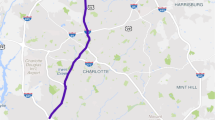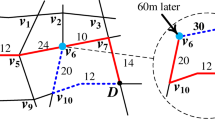Abstract
Various studies on dealing with the prediction of traffic variables have been conducted in the field of intelligent transportation systems (ITS) because of its significant role in facilitating traffic operation and management strategies. In particular, travel time has been recognized as an important parameter of such traffic variables for fully facilitating many ITS applications. However, an important research issue that existing studies have disregarded is to understand the characteristics of travel time data prior to performing traffic predictions. This study attempts to characterize the temporal evolution of travel times (referred to in this paper as travel time patterns), and explore the relationship between the characteristics and the prediction accuracy. Entropies used in information theory are utilized to characterize travel time data obtained from an advanced traffic surveillance system. Furthermore, three different types of prediction techniques are employed to perform one-step-ahead travel time prediction. Statistically modeled relationships based on regression analysis imply that better prediction can be performed by identifying travel time patterns. It is believed that the proposed approach would effectively support to conducting better travel time prediction.
Similar content being viewed by others
References
Adeli, H. (2000). “Feature extraction for traffic incident detection using wavelet transform and linear discriminant analysis.” Computer-Aided Civil and Infrastructure Engineering, Vol. 15,Issue 4, pp. 241–250.
Adeli, H. and Karim, A. (2000). “Fuzzy-wavelet RBFNN model for freeway incident detection.” Journal of Transportation Engineering, ASCE, Vol. 126,Issue 6, pp. 464–471.
Al-Deek, H. M. and Chandra, C. (2004). “New algorithms for filtering and imputation of real-time and archived dual-loop detector data in I-4 data warehouse.” In Transportation Research Record 1867, TRB, National Research Council, Washington D.C. pp. 116–126.
Bertini, R. and El-Geneidy, A. (2003). “Generating Transit Performance Measures with Archived Data.” In Transportation Research Record 1841, TRB, National Research Council, Washington D.C., pp. 109–119.
Bruce, L., Balraj, N., Zhang, Y., and Yu, Q. (2003). “Automated accident detection in intersections via digital audio signal processing.” In Transportation Research Record 1840, TRB, National Research Council, Washington D.C., pp. 186–192.
Coifman, R. R. and Wickerhouser, M. V. (1992). “Entropy-based algorithms for best basis selection.” IEEE Transactions on Information Theory, Vol. 38, No.2, pp. 713–718.
Coifman, R. R., Meyer, Y. and Wickerhouser, M. V. (1992). “Wavelet analysis and signal processing.” In Wavelets and Their Applications, Jones and Bartlett, Boston, Mass., pp. 153–178.
Daubechies, I. (1992). Ten Lectures on Wavelets, CBMS-NSF Conference Series in Applied Mathematics, Society for Industrial and Applied Mathematics, Philadelphia, PA.
Donoho, D. L. and Johnston, I. M. (1994). “Ideal denoising in an orhonormal basis chosen from a library of bases.” CRAS Paris, Ser. I, t. 319, pp. 1317–1322.
Elman, J. L. (1990). “Finding structure in time.” Cognitive Science, Vol. 14, No. 2, pp. 179–211.
Haykin, S. (1990). Adaptive filter theory, Prentice Hall, Englewood Cliffs, NJ. 1986.
Jiang, X. and Adeli, H. (2004). “Wavelet packet-autocorrelation function method for traffic flow pattern analysis.” Computer-Aided Civil and Infrastructure Engineering, Vol. 19, No. 5, pp. 324–337.
Kerner, B.S. (2004). “Three-phase traffic theory and highway capacity.” Physica A: Statistical and Theoretical Physics, Vol. 333, No. 15, pp. 379–440.
Mallat, S. G. (1989). “A theory for mutiresolution signal decomposition: The wavelet representation.” IEEE Transactions on Pattern Analysis and Machine Intelligence, Vol. 11, No. 7, pp. 674–693.
Misiti, M., Misiti, Y., Oppenheim, G., and Poggi, J. M. (2001). MATALB wavelet toolbox user’s guide version 2.1., The Math Works, Inc., Natick, Mass.
Oh, C., Ritchie, S. G., and Oh, J. (2005). “Exploring the relationship between data aggregation and predictability to provide better predictive traffic information.” In Transportation Research Record 1935, TRB, National Research Council, Washington D.C., pp. 28–35.
Park, B., Messer, C. J., and Urbanik II, T. (1998). “Short-term freeway traffic volume forecasting using radial basis function neural network.” In Transportation Research Record 1651, TRB, National Research Council, Washington, D.C.,pp. 39–47.
Park, D. and Rilett, L. R. (1998). “Forecasting multiple-period freeway link travel times using modular neural networks.” In Transportation Research Record 1617, TRB, National Research Council, Washington, D.C., pp. 163–170.
Park, D., Rilett, L. R., and Han, G. (1999). “Spectral basis neural networks for real-time travel time forecasting.” Journal of Transportation Engineering, ASCE, Vol. 125, No. 6, pp. 515–523.
Qiao, F., Liu, H., and Yu, L. (2006). “Incorporating wavelet decomposition technique to compress transguide ITS data.” Paper Presented at the 85th TRB Annual Meeting, Washington D.C., pp. 63–74.
Qiao, F., Wang, X., and Yu, L. (2003). “Optimizing aggregation level for intelligent transportation system data based on wavelet decomposition.” In Transportation Research Record 1840, TRB, National Research Council, Washington D.C., pp. 10–20.
Qiao, F., Yu, L., and Wang, X. (2004). “Double-sided determination of aggregation level for intelligent transportation system data.” In Transportation Research Record 1879, TRB, National Research Council, Washington D.C., pp. 80–88.
Rice, J. and van Zwet, E. (2004). “A simple and effective method for predicting travel times on freeways.” IEEE Transaction in Intelligent Transportation Systems, Vol. 5, No. 3, pp. 200–207.
Ritchie, S. G., Park, S., Oh, C., and Sun, C. (2001). Field investigation of advanced vehicle reidentification techniques and detector technologies, MOU 3008, Partners for Advanced Transit and Highways; Institute of Transportation Studies, University of California, Irvine.
Schlögl, A., Flotzinger, D., and Pfurtscheller, G. (1997). “Adaptive autoregressive modeling used for single-trial EEG classification.” BiomedizinischeTechnik, Vol. 42, No. 6, pp. 162–167.
Schmoyer, R., Hu, P., and Goeltz, R. (2001). “Statistical data filtering aggregation to hour totals of intelligent transportation system 30-s and 5-min vehicle counts.” In Transportation Research Record 1769, TRB, National Research Council, Washington D.C., pp. 79–86.
Shannon, C. E. (1948). “A mathematical theory of communication.” In Bell System Technical Journal, Vol. 27,Issue 3, pp. 379–423; 623–56, [Online] available at http://cm.bell-labs.com/cm/ms/what/shannonday/paper.html.
Trigg, D. W. and Leach, D. H. (1967). “Exponential smoothing with an adaptive response rate.” Operational Research Quarterly, Vol. 18, No. 1, pp. 53–59.
Turner, S., Albert, L., Gajewski, B., and Eisele, W. (2000). “Archived intelligent transportation system data quality: Preliminary analyses of san antonio transguide data.”In Transportation Research Record 1719, TRB, National Research Council, Washington D.C., pp. 77–84.
Van Lint, J. W. C. (2008). “Online learning solutions for freeway travel time prediction.” IEEE Transactions on Intelligent Transportation Systems, Vol. 9, No. 1, pp. 38–47.
Vlahogianni, E., Karlaftis, M., Golias, J., and Kourbelis, N. (2006). “Pattern-based short-term urban traffic predictor.” IEEE 9th International Intelligent Transportation Systems Conference, pp. 389–393.
Wall, Z. and Dailey, D. (2003). “Algorithm for detecting and correcting errors in archived traffic data.” In Transportation Research Record 1855, TRB, National Research Council, Washington D.C., pp. 183–190.
Widrow, B. and Sterns, S. S. (1985). Adaptive signal processing, Prentice Hall, Englewood Cliffs, NJ.
Wu, C., Ho, J., and Lee, D. (2004). “Travel time prediction with support vector regression.” IEEE Transactions on Intelligent Transportation Systems, Vol. 5, No. 4, pp. 276–281.
Xiao, H., Sun, H., and Ran, B. (2004). “Special factor adjustment model using fuzzy-neural network in traffic prediction.” In Transportation Research Record 1879, TRB, National Research Council, Washington D.C., pp. 17–23.
Xiao, H., Sun, H., Ran, B., and Oh, Y. (2003). “Fuzzy-neural network traffic prediction framework with wavelet decomposition.” In Transportation Research Record 1836, TRB, National Research Council, Washington D.C., pp. 16–20.
Yi, P., Sheng, Li., and Yu, L., (2004). “Wavelet transform for feature extraction to improve volume adjustment factors in rural roads.” In Transportation Research Record 1879, TRB, National Research Council, Washington D.C., pp. 24–29.
Zong, M., Sharma, S., and Lingras, P. (2004). “Genetically designed models for accurate imputation of missing traffic counts.” In Transportation Research Record 1879, TRB, National Research Council, Washington D.C., pp. 71–79.
Author information
Authors and Affiliations
Corresponding author
Rights and permissions
About this article
Cite this article
Oh, C., Park, S. Investigating the effects of daily travel time patterns on short-term prediction. KSCE J Civ Eng 15, 1263–1272 (2011). https://doi.org/10.1007/s12205-011-1123-y
Received:
Revised:
Accepted:
Published:
Issue Date:
DOI: https://doi.org/10.1007/s12205-011-1123-y




